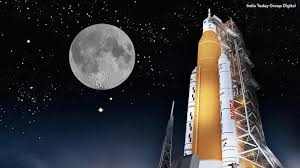Named after an ancient fossil of a pre-human ancestor, Lucy will become the first solar-powered spacecraft.
NASA was set on Saturday to launch a spacecraft called Lucy on a 12-year mission to explore for the first time a group of rocky bodies known as the Jupiter Trojan asteroids, gathering new insights into the solar system’s formation.
The Atlas V rocket responsible for propelling the probe is scheduled to take off on Saturday at 5.34am local time (9.34am GMT, 3.04pm IST) from Cape Canaveral.
Named after an ancient fossil of a pre-human ancestor, Lucy will become the first solar-powered spacecraft to venture so far from the sun and will observe more asteroids than any probe before it — eight in all.
Additionally, Lucy will do three Earth flybys for gravity assists, making it the first spacecraft to return to our planet’s vicinity from the outer solar system.
“Each one of those asteroids, each one of those pristine samples, provide a part of the story of the solar system, the story of us,” Thomas Zurbuchen, associate administrator of NASA’s Science Mission, told reporters on a call.
Lucy’s first encounter will be in 2025 with the asteroid, Donaldjohanson, in the Main Belt, between Mars and Jupiter. The body is named for the discoverer of the Lucy fossil.
Between 2027 and 2033, it will encounter seven Trojan asteroids — five in the swarm that leads to Jupiter, and two in the swarm that trails the gas giant.
The largest of them is about 60 miles (95 kilometres) in diameter.
Lucy will fly by its target objects within 250 miles (400 kilometres) of their surfaces, and use its onboard instruments and large antenna to investigate their geology, including composition, mass, density and volume.
A DIAMOND IN THE SKY
The Jupiter Trojan asteroids, thought to number well over 7,000, are leftover raw materials from the formation of our system’s giant planets — Jupiter, Saturn, Uranus and Neptune.
Scientists believe they hold vital clues about the composition and physical conditions in the protoplanetary disk from which all the Sun’s planets, including Earth, formed.
They are broadly grouped into two swarms — the leading swarm is one-sixth a lap ahead of Jupiter while the trailing swarm is one-sixth behind.
